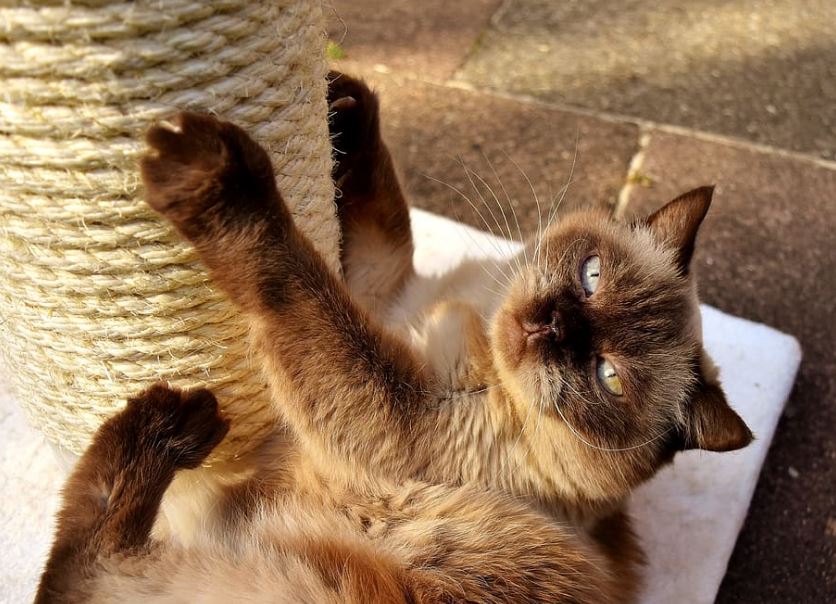Scratching is a normal cat behavior. They do it when they need to stretch and flex their bodies, keep their claws in tip-top condition, or in marking the area as territory. The catch is that they love to scratch on any surface their claws can dig into, be it the legs of your dining table or your brand new sofa. While you adore your cats, seeing the marks and shreds on your furniture and upholstery can be a frustrating experience.
Fortunately, you can avoid such a scenario by getting your cat a scratching post. While it may seem easy, encouraging your cat to use it is a different endeavor you need to take. To make things easier for you and your cat, and to protect your belongings, here are the best tips for training to use a scratching post.
Finding the Right Scratching Post
Before you start training your cat, the first you need to do is find a good scratching post. Doing so helps ensure that the process will work better and that your cat will be enticed to use it over and over again. Here are the main things to look for:
Height: Scratching is a way for cats to stretch their muscles, which is why you need to get one that is tall enough for your cat to fully extend her body and get the best stretch possible. A good height should allow your cat to cling her claws on top of the post and stretch up on her hind legs.
Weight: When fully extending their bodies, cats transfer their full weight onto the scratching post. Choose one that has a weighted base and is hefty enough not to be toppled over. Make sure to consider the cat’s age, too. A scratch post intended for kittens surely won’t be sturdy enough for an adult cat.
Type: Older or sick cats usually find it hard to lift their paws up, preventing them from using a vertical scratching post. In such a case, you need to get a horizontal scratch post or a scratching mat for their scratching needs.
Thread: Cats love vertical scratches, which means you must pick a scratching post with a vertical thread as well. Having horizontal thread will go against the direction of their scratch and can be uncomfortable for them, making them veer away from it and switch their attention to your other furniture instead.
Quantity: If you have more than one cat, you need to get one for each. That way, there will be no issues among them, marking their own territories. If possible, have an extra scratching post, just to avoid the fracas!
How to Train Your Cat to Use a Scratching Post
1. Place the scratching posts in ideal locations.
Most cats stretch after taking a long sleep, like how humans do in the morning. With that, placing the scratch post next to your cat’s preferred sleeping spot is one of the most practical things to do.
Alternatively, you may also place it on the spots your cat loves to scratch. For instance, you can place it in the kitchen if she usually targets your dining table. Otherwise, have it in the living room if she normally digs in her claws onto your rug, sofa, or living room door.
Another good place is where your cat enters and exits the house. By doing so, you can invite your cat to get a good scratch before she even decides to take on your upholsteries or curtain.
Place double-sided tapes onto the surface they were previously scratching. Cats dislike the feeling of the tape sticking to their paws and will go for a scratch on the post instead.
Once your cat forms a habit using the scratching post and you’re confident enough that she won’t revert back to her old doings, you can move the post to your desired location.
2. Entice your cat to the scratch post using catnip products.
If placing the scratch post to the listed locations won’t work, draw their attention to it instead by applying catnip-based products. You can either place a loose-leaf catnip on the top and base of the post or spritz it with a concentrated catnip spray. Don’t be surprised to see your cat immediately hanging around and investigating the scratching post. Soon, she’ll get a feel of the post and will return to it.
3. Use treats.
Apart from catnip, you can use treats to bait your cat to use the scratch post. Get your cat come over to the post by placing a small treat in your hand. Once she comes, put the treat on top of the post so your cat will reach for it. Chances are your feline will hit the post as she extends her paws up, allowing her to “experience” the post. Reward your cat afterward so she can have a positive association with the event.
On the next try, try to get your cat to mimic scratching by moving your hands up and down. Give your cat treats again as an incentive and lots of praise. Soon, she’ll consider the activity as a pleasurable one, being able to scratch her claws, while getting treats and having your attention at the same time.
4. Play with your cat.
Another way of training your cat to use her scratching post is by engaging her in a play. Like how you would do with treats, use a toy as bait in order to have your cat smacking and clawing at the post. Feather wands or teaser toys are brilliant for this activity. You can even have your cat chase the toy first before leading her to the post. Alternatively, you may hang the toy from the top and force your cat to jump and hit it about. Again, your cat would associate the game with positive emotion, increasing the chances of her using the post sooner or later.
Final Words
Like with any training, whether it’s teaching your cat to eat on her food pot or potty training your cat, teaching your beloved feline how to use a scratching requires patience and persistence. Eventually, your hard work will pay off and using the scratch post will become second nature to your cat, making it a positive experience for all.

